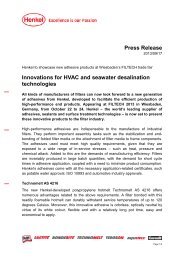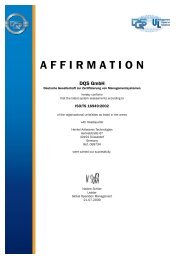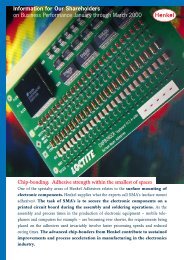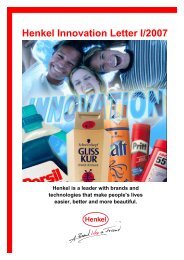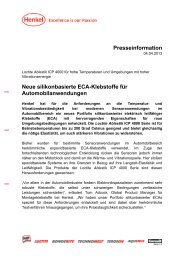Eccentric Rotor Pump Exzenter-Schneckenpumpe 97660 ... - Henkel
Eccentric Rotor Pump Exzenter-Schneckenpumpe 97660 ... - Henkel
Eccentric Rotor Pump Exzenter-Schneckenpumpe 97660 ... - Henkel
Sie wollen auch ein ePaper? Erhöhen Sie die Reichweite Ihrer Titel.
YUMPU macht aus Druck-PDFs automatisch weboptimierte ePaper, die Google liebt.
Operating Manual<br />
Bedienungsanleitung<br />
<strong>Eccentric</strong> <strong>Rotor</strong> <strong>Pump</strong><br />
<strong>Exzenter</strong>-<strong>Schneckenpumpe</strong><br />
<strong>97660</strong> 97663 97665 97669
2<br />
English...................................................................................................................... 3-14<br />
Deutsch .................................................................................................................. 15-27
Contents<br />
1 Please observe the following...................................................................................... 4<br />
1.1 Emphasized Sections .................................................................................................... 4<br />
1.2 For Your Safety.............................................................................................................. 4<br />
1.3 Field of Application (Intended Usage)............................................................................ 4<br />
2 Description ................................................................................................................... 5<br />
2.1 Theory of Operation....................................................................................................... 5<br />
2.2 Connections and Parts .................................................................................................. 6<br />
3 Technical Data ............................................................................................................. 7<br />
3.1 Specifications................................................................................................................. 7<br />
3.2 Dimensions .................................................................................................................... 8<br />
3.2.1 <strong>Eccentric</strong> <strong>Rotor</strong> <strong>Pump</strong> <strong>97660</strong>......................................................................................... 8<br />
3.2.1.1 <strong>Eccentric</strong> <strong>Rotor</strong> <strong>Pump</strong> with Bauer BG03-41...DC Drive................................................. 8<br />
3.2.1.2 <strong>Eccentric</strong> <strong>Rotor</strong> <strong>Pump</strong> with Indramat MKD 41 AC Drive (Option).................................. 8<br />
3.2.2 <strong>Eccentric</strong> <strong>Rotor</strong> <strong>Pump</strong> 97663, 97665 and 97669........................................................... 9<br />
3.2.2.1 <strong>Eccentric</strong> <strong>Rotor</strong> <strong>Pump</strong> with Bauer BG03-41...DC Drive................................................. 9<br />
3.2.2.2 <strong>Eccentric</strong> <strong>Rotor</strong> <strong>Pump</strong> with Indramat MKD 41 AC Drive (Option).................................. 9<br />
4 Assembly.................................................................................................................... 10<br />
4.1 <strong>Pump</strong>/Drive by Using the Special Key ......................................................................... 10<br />
4.2 Preparing the Drive by Using a Parallel Pin................................................................. 10<br />
5 Start Up....................................................................................................................... 11<br />
5.1 Preparations ................................................................................................................ 11<br />
5.2 Installation.................................................................................................................... 12<br />
6 Maintenance ............................................................................................................... 12<br />
6.1 Service Interval ............................................................................................................ 12<br />
6.2 Changing the Drive ...................................................................................................... 12<br />
7 Troubleshooting ........................................................................................................ 13<br />
8 Annex.......................................................................................................................... 14<br />
8.1 Spare Parts.................................................................................................................. 14<br />
8.2 Manufacturer’s Declaration.......................................................................................... 14<br />
3
4<br />
1 Please observe the following<br />
1.1 Emphasized Sections<br />
Warning!<br />
Refers to safety regulations and requires safety measures that protect the operator or<br />
other persons from injury or danger to life.<br />
Caution!<br />
Emphasizes what must be done or avoided so that the unit or other property is not<br />
damaged.<br />
Notice<br />
Gives recommendations for better handling of the unit during operation or adjustment as<br />
well as for service activities.<br />
The numbers printed in bold in the text refer to the corresponding position numbers in the<br />
illustration on page 6.<br />
<br />
• The point emphasizes an instruction step.<br />
As a result of technical development, the illustrations and descriptions in this operating<br />
manual can deviate in detail from the actual unit delivered.<br />
1.2 For Your Safety<br />
For safe and successful operation of the unit, read these instructions completely. The<br />
manufacturer cannot be held responsible for damage or injury of any kind because of<br />
misuse or improper application or because of failure to observe safety instructions or<br />
warnings.<br />
Be sure to retain this manual for future reference.<br />
Read and understand operator's manual before using this machine. Failure to follow<br />
operating instructions could result in injury or damage to equipment.<br />
Do not remove, by-pass or disable any safety device! It can result in damage to the unit<br />
and is therefore prohibited!<br />
If chemical products are not properly handled, damage to health can result!<br />
Observe general safety regulations for the handling of chemicals!<br />
Observe manufacturer’s instructions!<br />
The unit may be opened and repaired only by an authorized Loctite service<br />
representative.<br />
Dry running of the pump must be prevented under all circumstances, because<br />
dry running causes destruction of the stator!<br />
1.3 Field of Application (Intended Usage)<br />
The <strong>Eccentric</strong> <strong>Rotor</strong> <strong>Pump</strong> is suitable for exact application of Loctite silicones and<br />
anaerobic adhesives, except of such products containing abrasive ingredients.<br />
It is used in automatic workplaces, e. g. transfer lines, robot workplaces etc., for<br />
dispensing beads onto workpieces such as flanges.
2 Description<br />
2.1 Theory of Operation<br />
<strong>Eccentric</strong> <strong>Rotor</strong> <strong>Pump</strong>s are positive-displacement pumps.<br />
The main parts of the pump are the rotor made of stainless steel and rotating within the<br />
stator made of an elastomer.<br />
This kind of pump dispenses volumetrically and nearly free of pulsation.<br />
The volume flow depends on the size of the pump and the number of revolutions.<br />
The pump is available with either a digital AC drive or a DC drive.<br />
<strong>Pump</strong> and drive are fixed together with a clamping nut to enable a fast assembly<br />
resp. disassembly.<br />
Generally the pump is equipped with a shut-off valve at the product outlet. The reason is<br />
the capability of self-sealing gets lost with increasing life span.<br />
The pumps are available in 3 different sizes. The first number defines the periods of the<br />
spiral, the second the diameter in mm:<br />
Type<br />
Loctite order<br />
code no.<br />
4RD6 97665<br />
3RD8 97663 and 97669<br />
3RD12 <strong>97660</strong><br />
Two different elastomer are used for the stators, EPDM and the more expensive<br />
Vischem 05.<br />
EPDM Stator <strong>97660</strong>, 97663<br />
ViscChem 05 Stator 97665, 97669<br />
EPDM is applicable for silicones only.<br />
Vischem 05 is predominantly applicable for anaerobics, but also for silicones.<br />
5
6<br />
2 Description<br />
2.2 Connections and Parts<br />
<strong>97660</strong><br />
1<br />
13<br />
1 2 3 4 5 6 7 8<br />
13<br />
1 Mounting Clamp 9 Stator Housing<br />
2 Shaft Sealing Ring, top 10 Adapter Ring (97665 only)<br />
3 Shaft Sealing Ring, middle 11 Vent screw<br />
4 Shaft Sealing Ring, bottom 12 Lock Screw – Filling bore for<br />
5 <strong>Rotor</strong> with flexible Shaft block medium (Loctite 8104)<br />
6 <strong>Pump</strong> Housing 13 Bearing<br />
7 Grub Screw to fix the stator 14 Reducer G3/8 to G1/4<br />
8 Stator<br />
2 3 4<br />
12<br />
11<br />
12 (only 97665)<br />
11<br />
G1/2<br />
G1/2<br />
97663 97665 97669<br />
5 6 7 8<br />
10<br />
9<br />
SW 17<br />
G1/4<br />
9<br />
SW 21<br />
SW 24<br />
14<br />
G1/4
3 Technical Data<br />
3.1 Specifications<br />
Approved Loctite<br />
Products Silicones<br />
Approved Loctite<br />
Products Anaerobics<br />
Maximum Inlet<br />
Pressure<br />
Pressure control for<br />
Silicones<br />
<strong>97660</strong><br />
Capacity for 5900 3.0 g/s at 20° C,<br />
150 rpm,<br />
3 mm nozzle<br />
Capacity for Anaerobic<br />
Gasket Products<br />
97663<br />
97669<br />
97665<br />
5900, 5970 5083, 5699, 5900, 5910, 5960, 5970<br />
510,518,5203,<br />
5205,5206,5209<br />
* 97669 only<br />
20 bar dynamic, 30 bar static<br />
510,518,5203,<br />
5205,5206,5209<br />
Tube length between inlet of the pump and<br />
pressure regulator maximum 2 m with inner diameter<br />
min. 16 mm. Adjustment of the pressure regulator<br />
is typically set to 20-30 bar.<br />
0.6 g/s at 20° C,<br />
150 rpm,<br />
2 mm nozzle<br />
0,5 g/s at 20° C,<br />
150 min -1 ,<br />
2-mm nozzle<br />
* 97669 only<br />
0.3 g/s at 20° C,<br />
200 rpm,<br />
2 mm nozzle<br />
0.3 g/s at 20° C,<br />
200 rpm,<br />
1.5 mm nozzle<br />
Self Sealing Capability Dependent on viscosity; min. 2 bar for air pressure<br />
Starting Torque 2.5 Nm 2 Nm<br />
Continuous Torque 2.4 Nm 2 Nm 1.5 Nm<br />
Maximum allowed<br />
Torque<br />
5 Nm<br />
Typical Rotary Speed 100 rpm up to 150 rpm;<br />
at more than 150 rpm the wear rises disproportionate.<br />
Limit the max. rotary speed to 150 rpm at the drive controller.<br />
Motor shaft Diameter 14 mm with modified key 8964081<br />
or parallel pin<br />
DIN 7 –5m6x20<br />
Product Inlet G1/2<br />
Product Outlet G3/8 G1/4<br />
Life Time From first filling with product, based on an average power-on<br />
time of 8 hours per shift, the eccentric rotor pump has an<br />
expected life time of about 1600 hours.<br />
Barrier Fluid<br />
Loctite 8104<br />
(for silicones only)<br />
All data for silicones are referring to Loctite 5900, standard extrusion rate according to<br />
data sheet 20 – 80 g/min.<br />
7
8<br />
3 Technical Data<br />
3.2 Dimensions<br />
3.2.1 <strong>Eccentric</strong> <strong>Rotor</strong> <strong>Pump</strong> <strong>97660</strong><br />
3.2.1.1 <strong>Eccentric</strong> <strong>Rotor</strong> <strong>Pump</strong> with Bauer BG03-41...DC Drive<br />
135 mm<br />
5.3"<br />
48 mm<br />
1.9"<br />
124 mm<br />
4.9"<br />
60 mm<br />
2.35"<br />
40 mm<br />
1.57"<br />
274 mm + 0.4 mm<br />
10.78" + 0.015"<br />
3.2.1.2 <strong>Eccentric</strong> <strong>Rotor</strong> <strong>Pump</strong> with Indramat MKD 41 AC Drive (Option)<br />
111 mm<br />
41 mm 4.4"<br />
1.6"<br />
82 mm<br />
3.2"<br />
M6<br />
40 mm<br />
1.57"<br />
M6<br />
545 mm<br />
21.5"<br />
545 mm<br />
12.5"<br />
290.5 mm + 0.4 mm<br />
11.44" + 0.015"<br />
39 mm<br />
1.535"<br />
39 mm<br />
1.535"
3 Technical Data<br />
3.2.2 <strong>Eccentric</strong> <strong>Rotor</strong> <strong>Pump</strong> 97663, 97665 and 97669<br />
3.2.2.1 <strong>Eccentric</strong> <strong>Rotor</strong> <strong>Pump</strong> with Bauer BG03-41...DC Drive<br />
135 mm<br />
5.3"<br />
48 mm<br />
1.9"<br />
124 mm<br />
4.9"<br />
60 mm<br />
2.35"<br />
446 mm<br />
17.5"<br />
M6<br />
40 mm<br />
1.57"<br />
193 mm + 0.4 mm<br />
7.6" + 0.015"<br />
3.2.2.2 <strong>Eccentric</strong> <strong>Rotor</strong> <strong>Pump</strong> with Indramat MKD 41 AC Drive (Option)<br />
111 mm<br />
4.4"<br />
41 mm<br />
1.6"<br />
82 mm<br />
3.2"<br />
463 mm<br />
18.2"<br />
M6<br />
40 mm<br />
1.57"<br />
209.5 mm + 0.4 mm<br />
8.25" +<br />
0.015"<br />
27 mm<br />
1.06"<br />
27 mm<br />
1.06"<br />
9
10<br />
4 Assembly<br />
4.1 <strong>Pump</strong>/Drive by Using the Special Key<br />
As a standard the drive of the rotor pump will be mounted with a special key. The key is<br />
supplied with the <strong>Eccentric</strong> <strong>Rotor</strong> <strong>Pump</strong>.<br />
• Apply a small drop of adhesive Loctite 638 to the ground of the groove.<br />
• Put the key into the groove as shown in<br />
the graphic.<br />
• Wipe off the adhesive, which is welled<br />
out of the nut otherwise, it will stuck<br />
together with the shaft.<br />
• Only in connection with the Bauer drive:<br />
Mount the bushing onto the shaft and<br />
tight the screw.<br />
• Mount the pump.<br />
Pay attention to the seat of the key. If the<br />
key is not quite correctly mounted you can<br />
see a small gap between the clamping<br />
yaws of the adapter and the pump.<br />
The pump is not axially aligned. During<br />
operation the pump will be damaged!<br />
4.2 Preparing the Drive by Using a Parallel Pin<br />
A parallel pin can be mounted instead of the special key (<strong>97660</strong> only).<br />
<br />
Specification of the parallel pin: ISO 2338 – 5m6x20 – St<br />
• Prepare the shaft of the drive according<br />
to the left graphic.<br />
• Apply a small drop of adhesive<br />
Loctite 638 at the middle of the pin.<br />
• Put the pin into the bore according to the<br />
right graphic.<br />
• Wipe off the adhesive which is welled<br />
out at the pin.<br />
Pay attention to the length of the pin. It<br />
has to look out of the shaft with the same<br />
length on both ends.<br />
Let the adhesive cure otherwise it will<br />
stick together with the shaft of the pump.<br />
10 mm<br />
0.4 inch<br />
5 H9<br />
= =
5 Start Up<br />
When pump is running, the connected dispensing valve resp. shut-off valve<br />
must always be opened.<br />
The pump never should be driven with more than 150 rpm.<br />
Dry running of the pump must be prevented under all circumstances, because dry<br />
running causes destruction of the stator!<br />
Exception:<br />
Only for Start Up and only with < 20 rpm and maximal 30 sec.<br />
For safe and successful operation of the <strong>Eccentric</strong> <strong>Rotor</strong> <strong>Pump</strong>, read these instructions<br />
completely and follow them step by step.<br />
5.1 Preparations<br />
For the first initialization:<br />
The complete dispensing system is not filled with Loctite product yet.<br />
• Check the direction of rotation before<br />
mounting the pump.<br />
When looking through the check bore at<br />
the mounting flange, the shaft has to turn<br />
from the left to the right.<br />
• Check max. and min. rotation per minute.<br />
Dispense mode:<br />
DC drive:<br />
At max. control voltage, e. g. Bauer drive at 10 V DC, the revolution speed must not<br />
exceed 150 rpm.<br />
AC servo drive:<br />
The max. adjustable value of the revolution speed has to correspond to the max.<br />
revolution speed of the pump (150 rpm)<br />
Filling mode:<br />
At a PLC controlled system check, if the revolution speed for filling is accordingly<br />
adjusted smaller than 20 rpm.<br />
• By using the clamping nut 1 mount the pump to the mounting flange.<br />
The special key has to be mounted correctly therewith the pump is aligned correctly,<br />
see section 4.1.<br />
• Connect the feedline to the product input fitting at the pump.<br />
11
12<br />
5 Start Up<br />
5.2 Installation<br />
<br />
• At the controller switch to filling mode.<br />
• Fill the product supply unit with Loctite product, if not yet done.<br />
• Unscrew vent screw 11 placed at the opposite side of the product fitting.<br />
Do not loose the sealing ring at the screw. Use only original stainless steel screw!<br />
• Set product supply unit under pressure and fill the system with product until it comes<br />
out of the rotor pump’s vent bore.<br />
Depending on the length of the feedline and the viscosity of the product the filling can<br />
last from a few minutes till app. 1 hour.<br />
• Close vent bore with screw 11.<br />
Depending on the viscosity of the product the product pressure for the filling process<br />
should be between 1 and 4 bar for anaerobics and between 20 and 30 bar for silicones.<br />
• Now switch on the rotor pump and the dispensing valve resp. the shut-off valve.<br />
Every time, when the rotor pump is dispensing, the dispensing valve resp. the<br />
shut-off valve has to be opened!<br />
• Dispense as long as the product comes out of dispensing valve resp. the shut-off valve<br />
in a bubble free manner.<br />
• Adjust product pressure at the product supply unit according to the dispensing task.<br />
Pay attention to the operating manual of the product supply unit.<br />
Product pressure too high:<br />
A static product pressure at the product inlet of the pump of more than 30 bar will<br />
damage the shaft sealing rings 2, 3, 4 and thereby the pump will be destroyed.<br />
• Switch the controller to dispense mode.<br />
6 Maintenance<br />
6.1 Service Interval<br />
Once filled with product the pump should be sent in for inspection once per year, no<br />
matter how much it has been used.<br />
Inspect the pump once per month for performance. In case of a noticeable decrease of<br />
product quantity, not caused by nozzle obstruction, replace the stator, see Section 7.<br />
6.2 Changing the Drive<br />
• Disassemble the old drive, drive adapter and the pump.<br />
• Prepare the drive according to the instructions on Section 4.1/4.2 and 5.1.<br />
• Mount the mounting flange to the new drive.<br />
• Assemble the pre-mounted drive, mounting flange and the eccentric rotor pump.<br />
• Mount the clamping nut and tighten the handle.<br />
• Follow the Start up instruction on Section 5.2.
7 Troubleshooting<br />
Type of Malfunction Possible Causes Corrections<br />
No product. – Clogged nozzle.<br />
– Dispensing valve resp. shutoff<br />
valve does not open.<br />
– <strong>Pump</strong> not filled with product.<br />
– Wrong rotation direction of the<br />
drive running the pump.<br />
– Product cured inside the<br />
pump.<br />
– Product cured inside the<br />
feedline.<br />
– Flexible shaft of the rotor<br />
inside the pump is broken.<br />
– Insufficient feed pressure.<br />
– Product supply unit not active.<br />
– Upper sealing rings of the<br />
pump damaged due to<br />
exceeded product pressure<br />
settings.<br />
Too little product. – Clogged nozzle.<br />
– Product pressure too low<br />
Product pressure varies<br />
below the minimum required<br />
value to properly feed the<br />
pump.<br />
– Speed too low.<br />
• Change nozzle.<br />
• Check actuating pressure<br />
hose and actuating<br />
pressure of the valves<br />
according to their operating<br />
manuals<br />
• Fill the pump, see<br />
Section 5.2.<br />
• Change the direction of the<br />
rotation, see graphic at<br />
section 5.1.<br />
• Change pump.<br />
• Change feedline.<br />
• Change pump.<br />
• Adjust proper feed<br />
pressure.<br />
• Switch on supply unit.<br />
• Change pump.<br />
• Change nozzle.<br />
• Increase product pressure.<br />
• Increase speed<br />
No more than the speed<br />
limitation of 150 rpm!<br />
Too little product. – Stator damaged or wasted. • Change stator, thereby<br />
+ Depressurize the<br />
complete system.<br />
+ At the pump outlet<br />
disassemble the<br />
feedline and/or the shut-<br />
off valve<br />
+ Unscrew the stator<br />
housing 9.<br />
+ Unscrew grub screw 7.<br />
+ Change stator.<br />
+ Insert a new stator and<br />
turn it as long as the<br />
notch can be seen<br />
through the taped hole<br />
of the housing.<br />
+ Secure stator with the<br />
grub screw.<br />
+ Assemble parts in<br />
reversed order.<br />
+ Pressurize the system.<br />
13
14<br />
8 Annex<br />
8.1 Spare Parts<br />
Pos. No. Description Loctite Order No.<br />
1 <strong>Eccentric</strong> <strong>Rotor</strong> <strong>Pump</strong> 3RD8-L (EPDM) 97663<br />
<strong>Eccentric</strong> <strong>Rotor</strong> <strong>Pump</strong> 3RD8-L (Vischem 05) 97669<br />
<strong>Eccentric</strong> <strong>Rotor</strong> <strong>Pump</strong> 3RD12-L (EPDM) <strong>97660</strong><br />
<strong>Eccentric</strong> <strong>Rotor</strong> <strong>Pump</strong> 4RD6-L (Vischem 05) 97665<br />
2 Bauer BG03-41...EMV Drive 8964078<br />
AC Servo Drive Indramat MKD041 8964127<br />
3 Mounting Flange for Bauer drive 8964079<br />
Mounting Flange for Indramat MKD041 8964128<br />
4 Stator for <strong>97660</strong> (EPDM) 97661<br />
Stator for 97663 (EPDM) 97666<br />
Stator for 97665 (Vischem 05) 97667<br />
Stator for 97669 (Vischem 05) 97677<br />
5 Clamping nut 97662<br />
6 Dispensing nozzle Al 1,5 mm (for silicone) 8960603<br />
Dispensing nozzle Al 2,0 mm (for silicone) 8960604<br />
Dispensing nozzle Al 2,5 mm (for silicone) 8960655<br />
Dispensing nozzle Al 3,0 mm (for silicone) 8960654<br />
Dispensing nozzle POM 1,5 mm (for anaerobic) 8991033<br />
8.2 Manufacturer’s Declaration<br />
Manufacturer’s Declaration<br />
in accordance with the EC Directive Machinery 98/37/EEC<br />
The Manufacturer <strong>Henkel</strong> Loctite Deutschland GmbH<br />
Arabellastraße 17<br />
D-81925 München<br />
declares that the unit designated in the following is, as a result of its design and construction, in<br />
accordance with the European directives, harmonized standards and national standards listed<br />
below.<br />
Designation of the unit <strong>Eccentric</strong> <strong>Rotor</strong> <strong>Pump</strong> 3RD8-L w/o Drive<br />
<strong>Eccentric</strong> <strong>Rotor</strong> <strong>Pump</strong> 4RD6-L w/o Drive<br />
<strong>Eccentric</strong> <strong>Rotor</strong> <strong>Pump</strong> 3RD12-L w/o Drive<br />
Unit number <strong>97660</strong>, 97663, 97665, 97669<br />
Applicable EC Regulations EC Directive Machinery 98/37/EEC<br />
Applicable harmonized standards DIN EN 292-1, 1991.11; DIN EN 292-2, 1995.06<br />
DIN EN 809, 1998.10<br />
Date/Manufacturer’s signature 09/15/2000 / General Manager F. Löhr<br />
For changes to the unit that were not approved by Loctite, this declaration loses its<br />
validity.
Inhaltsverzeichnis<br />
1 Bitte beachten Sie...................................................................................................... 16<br />
1.1 Hervorhebungen .......................................................................................................... 16<br />
1.2 Zu Ihrer Sicherheit ....................................................................................................... 16<br />
1.3 Einsatzbereich (Bestimmungsgemäße Verwendung).................................................. 16<br />
2 Gerätebeschreibung.................................................................................................. 17<br />
2.1 Funktionsbeschreibung................................................................................................ 17<br />
2.2 Anschlüsse und Teile................................................................................................... 18<br />
3 Technische Daten ...................................................................................................... 19<br />
3.1 Spezifikationen ............................................................................................................ 19<br />
3.2 Abmessungen.............................................................................................................. 20<br />
3.2.1 <strong>Exzenter</strong>-<strong>Schneckenpumpe</strong> <strong>97660</strong>.............................................................................. 20<br />
3.2.1.1 <strong>Exzenter</strong>-<strong>Schneckenpumpe</strong> mit Bauer BG03-41...DC-Antrieb .................................... 20<br />
3.2.1.2 <strong>Exzenter</strong>-<strong>Schneckenpumpe</strong> mit Indramat MKD 41-AC-Antrieb (optional)................... 20<br />
3.2.2 <strong>Exzenter</strong>-<strong>Schneckenpumpe</strong> 97663, 97665 und 97669................................................ 21<br />
3.2.2.1 <strong>Exzenter</strong>-<strong>Schneckenpumpe</strong> mit Bauer BG03-41...DC- Antrieb ................................... 21<br />
3.2.2.2 <strong>Exzenter</strong>-<strong>Schneckenpumpe</strong> mit Indramat MKD 41-ACAntrieb (optional) .................... 21<br />
4 Montieren.................................................................................................................... 22<br />
4.1 <strong>Pump</strong>e/Antrieb mit Spezial-Passfeder ......................................................................... 22<br />
4.2 <strong>Pump</strong>e/Antrieb mit Zylinderstift.................................................................................... 22<br />
5 Inbetriebnehmen........................................................................................................ 23<br />
5.1 Vorbereitungsmaßnahmen .......................................................................................... 23<br />
5.2 Inbetriebnehmen.......................................................................................................... 24<br />
6 Wartung ...................................................................................................................... 24<br />
6.1 Wartungsintervalle ....................................................................................................... 24<br />
6.2 Auswechseln des Antriebes......................................................................................... 24<br />
7 Fehlersuche................................................................................................................ 25<br />
8 Anhang ....................................................................................................................... 27<br />
8.1 Ersatzteile .................................................................................................................... 27<br />
8.2 Herstellererklärung ...................................................................................................... 27<br />
15
16<br />
1 Bitte beachten Sie<br />
1.1 Hervorhebungen<br />
Gefahr!<br />
Verweist auf Sicherheitsregeln und fordert Vorsichtsmaßnahmen, die den Betreiber des<br />
Gerätes oder andere Personen vor Verletzungen oder Lebensgefahr schützen.<br />
Achtung!<br />
Hebt hervor, was getan oder unterlassen werden muss, um das Gerät oder andere<br />
Sachwerte nicht zu beschädigen.<br />
Hinweis<br />
Gibt Empfehlungen zum besseren Handhaben des Gerätes bei Bedien- und<br />
Einstellvorgängen sowie Pflegearbeiten.<br />
Die fett gedruckten Zahlen im Text beziehen sich auf die entsprechende<br />
Positionsnummer in der Abbildung auf Seite 18.<br />
<br />
• Der Punkt hebt einen Handlungsschritt hervor.<br />
Bedingt durch die technische Entwicklung können Abbildungen und Beschreibungen in<br />
dieser Bedienungsanleitung vom tatsächlich ausgelieferten Gerät in Details abweichen.<br />
1.2 Zu Ihrer Sicherheit<br />
Für den gefahrlosen und erfolgreichen Einsatz des Gerätes diese Anleitung vollständig<br />
lesen. Werden die Anweisungen nicht befolgt, übernimmt der Hersteller keine Garantie.<br />
Diese Bedienungsanleitung für eine spätere Verwendung aufbewahren.<br />
Entfernen, Überbrücken oder Außerkraftsetzen der Sicherheitseinrichtungen kann zu<br />
Schäden am Gerät führen und ist deshalb verboten!<br />
Allgemeine Sicherheitsvorschriften und Herstellerhinweise für den Umgang mit<br />
Chemikalien beachten!<br />
Bei unsachgemäßem Umgang mit chemischen Produkten können Gesundheitsschäden<br />
auftreten!<br />
Sicherheitsdatenblatt des eingesetzten LOCTITE-Produkts anfordern!<br />
Das Gerät darf nur vom autorisierten Loctite-Service geöffnet und repariert werden.<br />
Das Trockenlaufen der <strong>Schneckenpumpe</strong> ist unter allen Umständen zu vermeiden,<br />
weil dadurch der Stator zerstört wird!<br />
1.3 Einsatzbereich (Bestimmungsgemäße Verwendung)<br />
Die <strong>Exzenter</strong>-<strong>Schneckenpumpe</strong> eignet sich für das exakte Dosieren von Loctite-<br />
Silikonen und anaeroben Kleb-/Dichtstoffen. Ausgenommen sind abrasive Produkte.<br />
Sie wird in automatisierten Montageplätzen, z.B. in Fertigungsstraßen, Roboterstationen,<br />
zum Dosieren von Dichtraupen auf Werkstücken, wie Flansche, eingesetzt.
2 Gerätebeschreibung<br />
2.1 Funktionsbeschreibung<br />
<strong>Exzenter</strong>-<strong>Schneckenpumpe</strong> ist eine Verdrängerpumpe.<br />
Die <strong>Pump</strong>e besteht aus zwei Hauptkomponenten: dem <strong>Rotor</strong> aus Edelstahl der sich im<br />
Stator aus einem Elastomer dreht.<br />
Diese <strong>Pump</strong>enbauart dosiert volumetrisch und annähernd pulsationsfrei.<br />
Der Volumendurchfluss wird von der Größe der <strong>Pump</strong>e und der Anzahl der<br />
Umdrehungen bestimmt.<br />
Die <strong>Pump</strong>e ist verfügbar entweder mit digitalem AC-Servo- oder einem Gleichstrom-<br />
Getriebemotor.<br />
<strong>Pump</strong>e und Antrieb werden mit einer Montageschelle miteinander befestigt, um eine<br />
schnelle Montage bzw. Demontage zu ermöglichen.<br />
Generell ist die <strong>Pump</strong>e ausgangsseitig mit einem Schließventil ausgerüstet, da sich<br />
das Selbstdichtungsvermögen mit zunehmender Gebrauchsdauer verschlechtern kann.<br />
Die <strong>Pump</strong>en stehen in 3 verschiedenen Größen zur Verfügung. Dabei bezeichnet die<br />
erste Zahl die Schneckenperioden, die zweite den Durchmesser in mm:<br />
Typ Loctite-Bestellnr.<br />
4RD6 97665<br />
3RD8 97663 und 97669<br />
3RD12 <strong>97660</strong><br />
Es kommen zwei verschiedene Elastomere für die Statoren zum Einsatz, EPDM und das<br />
aufwändiger herzustellende Vischem 05.<br />
EPDM-Stator <strong>97660</strong>, 97663<br />
ViscChem 05 Stator 97665, 97669<br />
EPDM ist für Silikone geeignet.<br />
Vischem 05 ist vorwiegend für anaerobe Kleb-/Dichtstoffe geeignet, aber auch für<br />
Silikone.<br />
17
18<br />
2 Gerätebeschreibung<br />
2.2 Anschlüsse und Teile<br />
<strong>97660</strong><br />
1<br />
13<br />
1 2 3 4 5 6 7 8<br />
13<br />
1 Montageschelle 9 Statorgehäuse<br />
2 Wellendichtungsring, oben 10 Adapterring (nur 97665)<br />
3 Wellendichtungsring, Mitte 11 Entlüftungsschraube<br />
4 Wellendichtungsring, unten 12 Verschlussschraube - Füllloch für<br />
5 <strong>Rotor</strong> mit flexibler Welle Sperrmedium (Loctite 8104)<br />
6 <strong>Pump</strong>engehäuse 13 Lager<br />
7 Gewindestift zur Statorfixierung 14 Reduktionsstück G3/8 auf G1/4<br />
8 Stator<br />
2 3 4<br />
12<br />
11<br />
12 (only 97665)<br />
11<br />
G1/2<br />
G1/2<br />
97663 97665 97669<br />
5 6 7 8<br />
10<br />
9<br />
SW 17<br />
G1/4<br />
9<br />
SW 21<br />
SW 24<br />
14<br />
G1/4
3 Technische Daten<br />
3.1 Spezifikationen<br />
Zulässige Loctite-<br />
Produkte – Silikone<br />
Zulässige Loctite-<br />
Produkte - Anaerobe<br />
Klebstoffe<br />
Maximaler<br />
Eingangsdruck<br />
Druckregelung bei<br />
Silikonen<br />
<strong>97660</strong><br />
Dosierrate für 5900 3,0 g/s bei 20° C,<br />
150 min -1 ,<br />
3-mm-Dosiernadel<br />
Dosierrate für anaerobe<br />
Dichtungsprodukte<br />
Selbstdichtungs-<br />
Vermögen<br />
97663<br />
97669<br />
97665<br />
5900, 5970 5083, 5699, 5900, 5910, 5960, 5970<br />
510,518,5203,<br />
5205,5206,5209<br />
* nur 97669<br />
20 bar dynamisch, 30 bar statisch<br />
510,518,5203,<br />
5205,5206,5209<br />
Schlauchlänge zwischen Druckregler und <strong>Pump</strong>eneingang<br />
max. 2 m mit Innen-Ø von mind. 16 mm.<br />
Druckregler wird in der Regel auf 20 - 30 bar eingestellt.<br />
0,6 g/s bei 20° C,<br />
150 min -1 ,<br />
2-mm-Dosiernadel<br />
0,5 g/s bei 20° C,<br />
150 min -1 ,<br />
2-mm-Dosiernadel<br />
* nur 97669<br />
0,3 g/s bei 20° C,<br />
150 min -1 ,<br />
2-mm-Dosiernadel<br />
0,3 g/s bei 20° C,<br />
150 min -1 ,<br />
1,5-mm-<br />
Dosiernadel<br />
Hängt von Viskosität ab; min. 2 bar für Luftdruck<br />
Anlaufdrehmoment 2,5 Nm 2 Nm<br />
Dauerdrehmoment 2,4 Nm 2 Nm 1,5 Nm<br />
Max. zulässiges<br />
Drehmoment<br />
Typische<br />
Drehgeschwindigkeit<br />
5 Nm<br />
100 min -1 bis 150 min -1 ;<br />
bei mehr als 150 min -1 nimmt der Verschleiß<br />
unverhältnismäßig zu.<br />
Max. Drehgeschwindigkeit auf 150 min -1 am Steuergerät des<br />
Antriebes beschränken.<br />
Motorwelle Durchmesser 14 mm mit modifizierter Passfeder 8964081<br />
oder Zylinderstift<br />
DIN 7 -5m6x20<br />
Produkteingang G1/2<br />
Produktausgang G3/8 G1/4<br />
Lebensdauer Von der ersten Füllung mit Produkt, bei einer<br />
durchschnittlichen Betriebsdauer von 8 Stunden pro Schicht,<br />
beträgt die erwartete Lebensdauer der <strong>Exzenter</strong>-<br />
<strong>Schneckenpumpe</strong> ca. 1.600 Stunden.<br />
Sperrmedium<br />
Loctite 8104<br />
(nur für Silikon)<br />
Alle Angaben für Silikone beziehen sich auf Loctite 5900, Extrusionsrate<br />
nach Datenblatt 20-80 g/min.<br />
19
20<br />
3 Technische Daten<br />
3.2 Abmessungen<br />
3.2.1 <strong>Exzenter</strong>-<strong>Schneckenpumpe</strong> <strong>97660</strong><br />
3.2.1.1 <strong>Exzenter</strong>-<strong>Schneckenpumpe</strong> mit Bauer BG03-41...Getriebemotor<br />
135 mm<br />
5.3"<br />
48 mm<br />
1.9"<br />
124 mm<br />
4.9"<br />
60 mm<br />
2.35"<br />
40 mm<br />
1.57"<br />
274 mm + 0.4 mm<br />
10.78" + 0.015"<br />
3.2.1.2 <strong>Exzenter</strong>-<strong>Schneckenpumpe</strong> mit Indramat MKD 41-AC-Antrieb (Optional)<br />
111 mm<br />
41 mm 4.4"<br />
1.6"<br />
82 mm<br />
3.2"<br />
M6<br />
40 mm<br />
1.57"<br />
M6<br />
545 mm<br />
21.5"<br />
545 mm<br />
12.5"<br />
290.5 mm + 0.4 mm<br />
11.44" + 0.015"<br />
39 mm<br />
1.535"<br />
39 mm<br />
1.535"
3 Technische Daten<br />
3.2.2 <strong>Exzenter</strong>-<strong>Schneckenpumpe</strong> 97663, 97665 und 97669<br />
3.2.2.1 <strong>Exzenter</strong>-<strong>Schneckenpumpe</strong> mit Bauer BG03-41... Getriebemotor<br />
135 mm<br />
5.3"<br />
48 mm<br />
1.9"<br />
124 mm<br />
4.9"<br />
60 mm<br />
2.35"<br />
446 mm<br />
17.5"<br />
M6<br />
193 mm + 0.4 mm<br />
7.6" + 0.015"<br />
3.2.2.2 <strong>Exzenter</strong>-<strong>Schneckenpumpe</strong> mit Indramat MKD 41-AC-Antrieb (Optional)<br />
111 mm<br />
4.4"<br />
41 mm<br />
1.6"<br />
82 mm<br />
3.2"<br />
463 mm<br />
18.2"<br />
40 mm<br />
1.57"<br />
M6<br />
40 mm<br />
1.57"<br />
209.5 mm + 0.4 mm<br />
8.25" +<br />
0.015"<br />
27 mm<br />
1.06"<br />
27 mm<br />
1.06"<br />
21
22<br />
4 Montieren<br />
4.1 <strong>Pump</strong>e/Antrieb mit Spezial-Passfeder<br />
Standardmäßig wird der Antrieb der <strong>Schneckenpumpe</strong> mit Hilfe der Spezial-Passfeder<br />
montiert. Die Passfeder ist im Lieferumfang der <strong>Pump</strong>e enthalten.<br />
• Einen kleinen Tropfen des Loctite-Klebstoffs 638 auf den Boden der Nut aufbringen.<br />
• Passfeder wie in der Abbildung gezeigt<br />
in die Nut einsetzen.<br />
• Überschüssigen Klebstoff an der<br />
Passfeder abwischen, da die <strong>Pump</strong>e<br />
sonst mit der Welle verklebt.<br />
• Nur in Verbindung mit einem Bauer-<br />
Motor: Hülse aufstecken und mit<br />
Schraube sichern.<br />
• <strong>Pump</strong>e montieren.<br />
Korrekten Sitz der Passfeder beachten.<br />
Ist die Passfeder nicht korrekt montiert,<br />
lässt sich ein kleiner Spalt zwischen den<br />
Klemmbacken des Adapters und der<br />
<strong>Pump</strong>e erkennen.<br />
Die <strong>Pump</strong>e ist dann nicht axial<br />
ausgerichtet. Bei Betrieb wird sie<br />
beschädigt!<br />
4.2 <strong>Pump</strong>e/Antrieb mit Zylinderstift<br />
Anstelle einer Spezial-Passfeder kann auch ein Zylinderstift montiert werden (möglich<br />
nur bei <strong>97660</strong>).<br />
<br />
Spezifikation des Zylinderstifts: ISO 2338 - 5m6x20 - St<br />
• Welle des Antriebes gemäß der<br />
Abbildung (links) vorbereiten.<br />
• Einen kleinen Tropfen des Loctite-<br />
Klebstoffs 638 auf die Mitte des Stiftes<br />
aufbringen.<br />
• Stift gemäß der Abbildung (rechts) in die<br />
Bohrung einsetzen.<br />
• Überschüssigen Klebstoff am Stift<br />
abwischen.<br />
Länge des Stiftes beachten. Er muss an<br />
beiden Seiten der Welle gleich weit<br />
herausragen.<br />
Klebstoff aushärten lassen, da der Stift<br />
sonst mit der Welle der <strong>Pump</strong>e verklebt.<br />
10 mm<br />
0.4 inch<br />
5 H9<br />
= =
5 Inbetriebnehmen<br />
Bei fördernder <strong>Schneckenpumpe</strong> muss immer das angeschlossene Dosierventil<br />
bzw. Schließventil geöffnet sein.<br />
Die <strong>Pump</strong>e sollte niemals mit mehr als 150 min -1 betrieben werden.<br />
Das Trockenlaufen der <strong>Pump</strong>e ist unter allen Umständen zu vermeiden, weil<br />
dadurch der Stator zerstört wird!<br />
Ausnahme:<br />
Nur beim Anfahren und nur mit < 20 min -1 und maximal für 30 Sekunden.<br />
Für den gefahrlosen und erfolgreichen Einsatz der <strong>Exzenter</strong>-<strong>Schneckenpumpe</strong> diese<br />
Anleitung vollständig lesen und Schritt für Schritt befolgen.<br />
5.1 Vorbereitungsmaßnahmen<br />
Nur bei Erstinbetriebnahme:<br />
Die gesamte Dosieranlage ist nicht mit Loctite-Produkt gefüllt.<br />
• Drehrichtung des Antriebs vor Einbau<br />
der <strong>Pump</strong>e prüfen.<br />
Beim Betrachten der Antriebswelle durch<br />
die Kontrollöffnung des Befestigungs-<br />
Flansches muss die Welle von links nach<br />
rechts drehen.<br />
• Maximale und minimale Drehzahl pro Minute prüfen.<br />
Dosierbetriebsart:<br />
DC-Antrieb:<br />
Bei max. Steuerspannung (z.B. Bauer-Antrieb: 10 V DC) darf die Drehzahl<br />
max. 150 min -1 nicht übersteigen.<br />
AC-Servoantrieb:<br />
Der max. eingestellte Wert für die Drehzahl des Antriebes muss der max. zulässigen<br />
Drehzahl der <strong>Pump</strong>e entsprechen (150 min -1 ).<br />
Befüllbetriebsart:<br />
Bei einer SPS-gesteuerten Anlage prüfen, ob die Funktion für das Füllen der <strong>Pump</strong>e<br />
ordnungsgemäß auf < 20 min -1 eingestellt ist.<br />
• <strong>Pump</strong>e an Befestigungsflansch montieren und mit der Montageschelle 1 befestigen.<br />
Die Passfeder muss korrekt in der Nut sitzen und damit die <strong>Schneckenpumpe</strong> richtig<br />
ausgerichtet sein, siehe Abschnitt 4.1.<br />
• Produktschlauch an Produktanschluss der <strong>Pump</strong>e anschließen.<br />
23
24<br />
5 Inbetriebnehmen<br />
5.2 Inbetriebnehmen<br />
<br />
• Steuerung auf Befüllbetriebsart umschalten (Handbetrieb).<br />
• Die Produkt-Versorgungseinheit mit Loctite-Produkt befüllen, falls nicht schon<br />
geschehen.<br />
• Entlüftungsschraube 11 auf der entgegengesetzten Seite des Produktanschlusses der<br />
<strong>Pump</strong>e öffnen.<br />
Dichtungsring an der Schraube nicht verlieren. Nur Original-Edelstahlschraube<br />
verwenden!<br />
• Produkt-Versorgungseinheit mit Druck beaufschlagen und System mit Produkt füllen,<br />
bis es aus der Entlüftungsbohrung der <strong>Schneckenpumpe</strong> austritt.<br />
Der Befüllvorgang kann je nach Schlauchlänge der Zuführleitung und Viskosität des<br />
Produktes von wenigen Minuten bis zu ca. 1 Stunde dauern.<br />
• Entlüftungsbohrung mit Schraube 11 verschließen.<br />
Je nach Produktviskosität sollte der Produktdruck für den Füllprozess bei anaeroben<br />
Produkten zwischen 1 und 4 bar und bei Silikonen zwischen 20 und 30 bar liegen.<br />
• <strong>Schneckenpumpe</strong> erst jetzt zuschalten und Dosierventil bzw. Schließventil öffnen.<br />
Bei fördernder <strong>Schneckenpumpe</strong> muss immer das Dosierventil bzw. Schließventil<br />
nach dem <strong>Pump</strong>enausgang geöffnet sein.<br />
• Solange dosieren bis Produkt blasenfrei aus dem Dosierventil bzw. Schließventil tritt.<br />
• Produktdruck gemäß der Dosieraufgabe in der Versorgungseinheit einstellen.<br />
Hierzu unbedingt Bedienungsanleitung der eingesetzten Versorgungseinheit<br />
beachten.<br />
Produktdruck zu hoch:<br />
Ein statischer Produktdruck auf der Eingangsseite der <strong>Pump</strong>e von mehr als 30 bar<br />
führt zu Schäden an den Dichtungsringen 2, 3, 4 und dadurch zur Zerstörung<br />
der <strong>Pump</strong>e.<br />
• Steuerung auf Automatikbetrieb umschalten.<br />
6 Wartung<br />
6.1 Wartungsintervalle<br />
Ist die <strong>Schneckenpumpe</strong> mit Produkt gefüllt, sollte sie mindestens einmal im Jahr zur<br />
Inspektion eingeschickt werden, unabhängig davon, wie oft sie benutzt wurde.<br />
Die Dosierleistung der <strong>Pump</strong>e sollte einmal im Monat überprüft werden. Im Falle eines<br />
feststellbaren Abfalls der Dosiermenge, die nicht auf eine verstopfte Dosiernadel<br />
zurückzuführen ist, muss der Stator ausgetauscht werden, siehe Abschnitt 7.<br />
6.2 Auswechseln des Antriebes<br />
• Den alten Antrieb, den Befestigungsflansch und die <strong>Pump</strong>e demontieren.<br />
• Zur Vorbereitung des Antriebes die Anweisungen in Abschnitt 4.1/4.2 und 5.1 befolgen.<br />
• Befestigungsflansch an den neuen Antrieb montieren.<br />
• Den vormontierten Antrieb und die <strong>Exzenter</strong>-<strong>Schneckenpumpe</strong> mit Hilfe der<br />
Montageschelle 1 verbinden.<br />
• Die Anweisungen unter Inbetriebnahme in Abschnitt 5.2 befolgen.
7 Fehlersuche<br />
Art der Störung Mögliche Ursachen Abhilfe<br />
Kein Produkt – Verstopfte Dosiernadel. • Dosiernadel wechseln.<br />
– Dosierventil bzw.<br />
• Steuerluftanschlüsse und<br />
Schließventil öffnet nicht. Steuerdruck der Ventile<br />
überprüfen, siehe<br />
Bedienungsanleitung der<br />
eingesetzten Ventile.<br />
– Kein Produkt in der <strong>Pump</strong>e.<br />
– Falsche Drehrichtung der<br />
<strong>Pump</strong>e.<br />
– Produkt in der <strong>Pump</strong>e<br />
ausgehärtet.<br />
– Produkt im Produktschlauch<br />
ausgehärtet.<br />
– Flexible Welle des <strong>Rotor</strong>s in<br />
der <strong>Pump</strong>e ist beschädigt.<br />
– Unzureichender Fülldruck.<br />
– Versorgungseinheit nicht<br />
aktiv.<br />
– Obere Dichtungsringe der<br />
<strong>Pump</strong>e wegen nicht<br />
ordnungsgemäßer<br />
Produktdruckeinstellungen<br />
beschädigt.<br />
Zu wenig Produkt – Verstopfte Dosiernadel<br />
– Produktdruck zu niedrig; liegt<br />
unter Mindestdruck, der für<br />
ordnungsgemäßes Füllen der<br />
<strong>Pump</strong>e erforderlich ist.<br />
– Geschwindigkeit zu niedrig.<br />
• <strong>Pump</strong>e füllen, siehe<br />
Abschnitt 5.2.<br />
• Drehrichtung korrigieren,<br />
siehe Grafik im Abschnitt<br />
5.1.<br />
• <strong>Schneckenpumpe</strong><br />
wechseln.<br />
• Produktschlauch wechseln.<br />
• <strong>Pump</strong>e wechseln.<br />
• Richtigen Fülldruck<br />
einstellen.<br />
• Versorgungseinheit aktiv<br />
schalten.<br />
• <strong>Schneckenpumpe</strong><br />
wechseln.<br />
• Dosiernadel wechseln.<br />
• Produktdruck erhöhen.<br />
• Geschwindigkeit erhöhen.<br />
Auf Drehzahllimit von<br />
150 min -1 achten!<br />
25
26<br />
7 Fehlersuche<br />
Art der Störung Mögliche Ursachen Abhilfe<br />
Zu wenig Produkt – Stator 8 defekt bzw.<br />
verschlissen<br />
• Stator austauschen, dazu:<br />
+ Komplette Anlage<br />
drucklos schalten.<br />
+ Am <strong>Pump</strong>enausgang<br />
Schlauch abnehmen<br />
und/oder montiertes<br />
Schließventil<br />
abmontieren.<br />
+ Statorgehäuse 9<br />
abschrauben.<br />
+ Gewindestift 7 lösen.<br />
+ Stator austauschen.<br />
+ Neuen Stator einsetzen<br />
und dabei so lange<br />
drehen bis Kerbe durch<br />
Gewindebohrung des<br />
Statorgehäuses sichtbar<br />
wird.<br />
+ Stator wieder mit<br />
Gewindestift sichern.<br />
+ Teile in umgekehrter<br />
Reihenfolge wieder<br />
montieren.<br />
+ Komplette Anlage<br />
wieder mit Druck<br />
beaufschlagen.
8 Anhang<br />
8.1 Ersatzteile<br />
Pos. Nr. Gerätebeschreibung Loctite-<br />
Bestellnummer<br />
<strong>Exzenter</strong>-<strong>Schneckenpumpe</strong> 3RD8-L (EPDM) 97663<br />
<strong>Exzenter</strong>-<strong>Schneckenpumpe</strong> 3RD8-L (Vischem 05) 97669<br />
<strong>Exzenter</strong>-<strong>Schneckenpumpe</strong> 3RD12-L (EPDM) <strong>97660</strong><br />
<strong>Exzenter</strong>-<strong>Schneckenpumpe</strong> 4RD6-L (Vischem 05) 97665<br />
2 Bauer BG03-41...EMV-Getriebemotor 8964078<br />
AC Servomotor Indramat MKD041 8964127<br />
3 Befestigungsflansch für Bauer-Getriebemotor 8964079<br />
Befestigungsflansch für Indramat MKD041 8964128<br />
4 Stator für <strong>97660</strong> (EPDM) 97661<br />
Stator für 97663 (EPDM) 97666<br />
Stator für 97665 (Vischem 05) 97667<br />
Stator für 97669(Vischem 05) 97677<br />
5 Montageschelle 97662<br />
6 Dosiernadel Al 1,5 mm (für Silikone) 8960603<br />
Dosiernadel Al 2,0 mm (für Silikone) 8960604<br />
Dosiernadel Al 2,5 mm (für Silicone) 8960655<br />
Dosiernadel Al 3,0 mm (für Silicone) 8960654<br />
Dosiernadel POM 1,5 mm (für anaerobe Klebstoffe) 8991033<br />
8.2 Herstellererklärung<br />
Herstellererklärung<br />
im Sinne der EU-Maschinen-Richtlinie 98/37/EWG<br />
Hersteller <strong>Henkel</strong> Loctite Deutschland GmbH<br />
Arabellastraße 17<br />
D-81952 München<br />
erklärt, dass das nachfolgend bezeichnete Gerät aufgrund seiner Konzipierung und Bauart den<br />
unten aufgeführten europäischen Richtlinien, harmonisierten Normen und nationalen Normen<br />
entspricht.<br />
Bezeichnung des Gerätes <strong>Exzenter</strong>-<strong>Schneckenpumpe</strong> 3RD8-L ohne Getriebe<br />
<strong>Exzenter</strong>-<strong>Schneckenpumpe</strong> 4RD6-L ohne Getriebe<br />
<strong>Exzenter</strong>-<strong>Schneckenpumpe</strong> 3RD12-L ohne Getriebe<br />
Gerätenummer <strong>97660</strong>, 97663, 97665, 97669<br />
Angewandte EU-Richtlinien EU-Maschinen-Richtlinie 98/37/EWG<br />
Angewandte harmonisierte Normen DIN EN 292-1, 1991.11; DIN EN 292-2, 1995.06<br />
DIN EN 809, 1998.10<br />
Datum/Hersteller-Unterschrift 15. September. 2000 / General Manager F. Löhr<br />
Bei einer nicht mit uns abgestimmten Änderung des Gerätes verliert diese Erklärung ihre<br />
Gültigkeit.<br />
Order Code No./Bestell-Nr. 8952102 – Edition/Ausgabe 09/2003<br />
27
<strong>Henkel</strong> Loctite Deutschland GmbH<br />
Arabellastraß e 17 Telefon 0 89/92 68-0<br />
D-81925 Mü nchen Telefax 0 89/9 10 19 78<br />
C<br />
<strong>Henkel</strong> Loctite Corporation 2003



